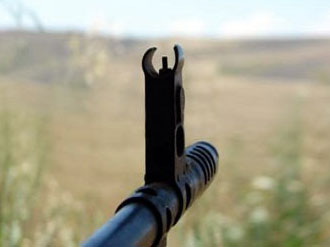Baku, Azerbaijan, Feb. 7
Trend:
The ceasefire between Azerbaijani and Armenian troops was violated by Armenia in 40 different positions along the contact line yesterday, the Azerbaijani Defense Ministry said on Feb.7.
Armenian Armed Forces fired on positions of the Azerbaijani Armed Forces located in the village of Gizilhajili in the Gazakh region from their positions in the village of Berkaber in Armenia's Ijevan region.
The Azerbaijani positions in the village of Kohanebi in the Tovuz region were fired on from Armenian positions located in Armenia's Berd region.
At the same time, the Azerbaijani positions were fired on from positions located near the villages of Garakhanbeyli and Ashagi Seyidahmadli in the Fizuli region- Merzili, Yusifjanli, Qaragashli, Shirvanli, Sarijali of the Agdam region- Chayli in the Terter region- Kuropatkino in the Khojavend region- Tapgaraqoyunlu in the Goranboy region- Mehdili in the Jabrayil region and at nameless heights in the Goygol region.
The shooting was countered by return fire.
The situation has remained tense on the contact line since mid-January.
A spokesman for the Azerbaijani Defense Ministry, told Trend that most ceasefire violations take place in the Fizuli, Agdam, Terter, Goranboy, Khojavend and Jabrayil regions.
Lieutenant-Colonel Vagif Dergahli emphasized that the number of truce violations and intensity of shootings have recently increased. The ceasefire has been violated over 2,000 times since Jan. 21. In every incident, the shooting was countered by return fire.
The OSCE Minsk Group co-chairs expressed their deep concern over continued violence in the region, according to the organization's statement on the results of the Paris meeting between Azerbaijani Foreign Minister Elmar Mammadyarov and Armenian Foreign Minister Edward Nalbandian.
The co-chairs stressed that recent incidents undermine negotiations and diminish the prospects for peace.
In addition, U.S. State Department Deputy Spokesperson Marie Harf said at a press briefing on Jan.24 that the use of force will not resolve the Nagorno-Karabakh conflict.
"We have seen the reports and regret any loss of life anywhere, but certainly here as well. Our position remains that the use of force will not resolve this conflict. We call on all parties to refrain from the use or threat of force," Harf said.
The conflict between the two South Caucasus countries began in 1988 when Armenia made territorial claims against Azerbaijan. Armenian armed forces have occupied 20 per cent of Azerbaijan since 1992, including the Nagorno-Karabakh region and seven surrounding districts.
Azerbaijan and Armenia signed a ceasefire agreement in 1994. The co-chairs of the OSCE Minsk Group, Russia, France and the U.S. are currently holding peace negotiations.
Armenia has not yet implemented the U.N. Security Council's four resolutions on the liberation of the Nagorno-Karabakh and the surrounding regions.
translated by NH
edited by CN






